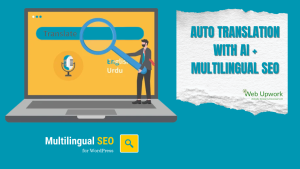In the last couple of years I have frequently heard clients ask: “Should my WordPress website support voice search? And what about chat-based or conversational interfaces?” The simple answer is: yes, absolutely — and the reasons are clearer than ever. The recent developments around voice search and conversational UI are reshaping how users find and interact with websites, making it vital for us as WordPress designers and developers to adapt. For clarity, by “voice search” I mean users speaking queries rather than typing them; and by “conversational UI” I mean interfaces (on a website or web-app) that let the user interact via natural language (voice or text) rather than just clicks and menus.
In this blog I’ll share: what the news and trends are, how they relate to WordPress sites, what I believe needs to be done, and what we as freelancers or clients should keep in mind.
What’s the news & why this is happening
Several articles and reports show a clear shift in user behaviour and search technology:
According to one recent piece, voice search and conversational UI are “two of the biggest trends transforming the way users engage with technology”.
Another article points out that voice search is no longer niche — more and more people are speaking to their phones, smart speakers, or other devices instead of typing.
There is also emphasis on how SEO is changing: voice queries tend to be longer, in full sentences, conversational, and often focused on “questions” rather than short keywords.
And importantly for WordPress site-owners: there are pieces that talk specifically about how to optimise a WordPress site for these trends.
So in short: users are changing how they search; technology (voice assistants, UI/UX) is adapting; and websites (including WordPress) have to catch up if they want to remain discoverable and usable.
Why I believe you should care as a WordPress designer
From my perspective working as a WordPress web designer, here are the key reasons I believe voice search + conversational UI deserve your attention:
User behaviour in India (and globally) is shifting
Many users prefer speaking rather than typing — especially on mobile, when they are commuting, multitasking, or using voice assistants. If your website doesn’t play nicely with such behaviour, you risk losing those visitors or conversions.Competitive edge and differentiation
Many business websites built on WordPress still follow the traditional model: search bar, navigation menus, keyword-rich content. If you add voice-friendly search or a conversational widget, you can stand out. It signals you are modern, user-centric.Improved accessibility and user-experience
Voice search and conversational UI help users who may have difficulty typing (elderly people, people on the go, people with disabilities). Good accessibility is not just “nice to have” it becomes a part of inclusive design, which also reflects well on your brand.SEO & discoverability benefits
The optimisation required for voice search (more natural language content, structured data/schema, faster pages) overlaps with good SEO practices anyway. So by catering to voice search, you are also improving your site in general. From the guides I read: voice queries are longer, conversational, and local context matters more.Future-proofing your work
As a freelancer I want to build websites that last and adapt. If I design now with voice search and conversational UI in mind, the site will remain relevant as user-expectations evolve. The earlier you adopt, the less you’ll feel you are playing catch-up.
How this applies to WordPress sites, concrete points
Given all of the above, here are the things I think you (as a WordPress site-owner or designer) should implement or at least plan for. I’ll list them as bullet-points so they are easy to reference.
a) Content & keyword strategy
Write content in a conversational tone, thinking about how a user might ask a question rather than how they might type a keyword. For example: “How can I book web design services in Indore?” rather than “web design Indore services”.
Use long-tail questions as headings: e.g., “What should I ask before hiring a WordPress designer?” this aligns with voice-search style queries.
Create an FAQ section (or pages) that answer common full-question queries succinctly. This tends to help with voice assistants grabbing answers.
Think local: Voice queries often include “near me”, “in my city”, so if your client is a local business, include geo- modifiers: city, area, landmark etc.
b) Technical / site performance aspects
Ensure the WordPress site loads very quickly, especially on mobile devices. Voice search users expect fast responses. The guides say page speed plays a major role in voice search optimisation.
Use a light, performant theme and minimise heavy scripts/plugins.
Ensure the site is mobile-friendly/responsive, since many voice searches happen on mobile.
Use structured data/schema markup: mark up FAQ sections, How To, LocalBusiness, etc, so that search engines (and voice assistants) can better interpret your content.
c) Conversational UI / voice interface implementation
Consider adding a voice search plugin or voice-assistant interface in WordPress: there are plugins or custom integrations that allow users to speak queries instead of typing.
Add a chatbot or conversational widget: giving users the option to ask “What services do you offer?”, “How do I contact you?”, etc in natural language, rather than navigating manually. This improves engagement and can reduce friction. The article on web apps mentions conversational UI making journeys smoother.
Map the user journey: design the conversational flows e.g., user asks a question, the bot/voice assistant gives answer, maybe suggests next step (contact form, booking, etc).
Keep the interface simple: Voice UI is more linear (user says something → system responds). You need to anticipate what questions users might ask and make sure your site (via UI or content) handles them well.
d) Local SEO & business listing considerations
For many voice searches the intent is local (e.g., “Where can I find a WordPress designer in Indore?”). So ensure the website mentions location, service area, contact details, business hours etc.
Make sure the business’s Google My Business (or equivalent) listing is updated, as voice may pull information directly from those listings.
Use local schema markup (“LocalBusiness” etc) to help voice assistants give accurate answers.
e) Analytics, monitoring & optimisation
Track what search queries visitors are using (on site search, voice queries if you can detect). Look for patterns of conversational or question-based queries.
A/B test content written in standard keywords vs. conversational style to see what performs better for voice traffic.
Monitor bounce rate / engagement from mobile/voice-related paths — because if a voice user asks something and the site fails to respond quickly, you may lose them.
Keep an eye on new plugins, themes and tools that support voice search or conversational UI — the field is evolving fast.
Some challenges and things to watch out for
Of course, there are caveats and things you need to be mindful about.
Predicting voice queries is harder: Unlike typed queries (where people type keywords), voice queries are more varied, longer, and can take many forms. So you cannot simply pick a handful of keywords and be done.
Content must be truly useful and direct: Because voice results often read out answers (or summaries) rather than rely on users skimming pages, your answers have to be clear, concise, and structured.
Technical debt: Adding voice/ conversational features can increase the complexity of your WordPress site (plugins, integrations). If you’re not careful, you may slow down the site, create maintenance burdens.
Voice accuracy / language nuances: In India especially, voice queries may include Hinglish, local dialects, accented speech. The system must handle those variations (at least via fallback to text).
Privacy / user comfort: Some users may hesitate to use voice (especially in public), so you should still retain traditional text search/navigation. Conversational UI should be optional, not forced.
Local vs global language: You might need to support multiple languages or local variants because users might speak in Hindi, English, or mixed. That complicates content strategy.
Search engine/voice assistant behaviour changes over time: What works today may shift quickly for example, how Google, Alexa, Siri interpret queries, what they prioritise. So this isn’t a “set and forget” task.
What I would recommend as next steps (for clients & freelancers)
From my working point of view (as a freelancer doing WordPress web design) here’s how I would approach this:
Initial audit
Check existing site: mobile-speed, theme size, plugin weight, content readability.
Check content: Are there FAQ or question-style headings? Do you have local references? Are you using structured data?
Check search behaviour: Are there site-search queries that users type? Any voice query data available?
Plan voice-friendly enhancements
Add or update FAQ sections with question-answer style.
Make one or two key pages (services, about, contact) “voice-ready” — write headings that reflect conversational queries.
Choose a lightweight theme/plugin stack to keep site performance good.
Implement structured data: FAQSchema, LocalBusiness, etc.
If budget/time permits: add a conversational UI (chatbot or voice interface) and allow voice search in site search.
Local optimisation
Ensure business location, service area, hours, contact info are clearly mentioned and marked up.
Encourage reviews (especially Google) because voice searches often rely on local trust signals.
Use location-based phrasing in content (city, area, near, etc).
Monitor and iterate
After launch, monitor mobile traffic, bounce rate, voice-related queries (if you can detect).
Ask clients if they notice users asking via voice, or being referred from smart devices.
Update content regularly: new FAQ, new question formats, remove outdated content.
Keep plugin/theme updates minimal and performance optimised (because slow sites kill voice UI experience).
Educate clients
As a freelancer, you should explain to your clients: “Here’s why voice search matters, here’s what it means for your site, here’s what additional cost/time it involves.”
Show them examples of what users might ask (e.g., “When does your service close on Saturday?”, “Can you show me budget web-design packages in Indore?”) and how the site will respond.
Set realistic expectations: voice search optimisation does not guarantee immediate huge traffic, but improves readiness, differentiation, and long-term positioning.
Why this fits very well with my freelance WordPress business & Upwork profile
Since I specialise in WordPress web design (and I operate on platforms like Upwork), embracing voice search + conversational UI aligns well for the following reasons:
It adds another value proposition to my service: I can tell clients “I build voice-friendly WordPress sites” — this differentiates me from many standard web designers.
It allows me to charge possibly a premium or an addon for “voice-search optimisation / conversational UI” because it involves extra work (content rewrites, plugin/integration, testing).
It helps me stay ahead of the curve: if I deliver a site built today with voice-friendly architecture, the client will likely see fewer issues in future. That reflects well on me (fewer re-works, happy clients, good Upwork reviews).
It aligns with trends: As voice becomes more dominant, clients who delay may find they need redesigns sooner. I can position myself as someone who builds “future-proof” WordPress sites.
The shift to voice search and conversational UI is more than just a buzzword. It is a meaningful change in how users search and interact with websites — especially via mobile, smart devices, and those “on-the-go” moments. For WordPress sites, this means the usual checklist (good SEO, mobile responsiveness, fast load times) remains important — but we now must layer on conversational content, voice-friendly navigation, structured data, and maybe even voice/ chatbot UI.
From my viewpoint, for any WordPress designer or freelancer aiming to stand out (especially in competitive marketplaces like Upwork), being able to offer a “voice-ready website” is a smart strategic move. It helps the client, it helps the designer, and most importantly, it helps the end-user who will increasingly prefer speaking to their device instead of typing.
Product Schema
{% if template.name == 'product' %}
<script type="application/ld+json">
{
"@context": "https://schema.org/",
"@type": "Product",
"name": "{{ product.title }}",
{%- if product.featured_media -%}
{%- assign media_size = product.featured_media.preview_image.width | append: 'x' -%}
"image": [
{{ product.featured_media | img_url: media_size | prepend: "https:" | json }}
],
{%- endif -%}
"description": {{ product.description | strip_html | json }},
"sku": "{{ current_variant.sku }}",
"mpn": "{{ current_variant.barcode }}",
"brand": {
"@type": "Brand",
"name": "District A Design"
},
"review": {
"@type": "Review",
"reviewRating": {
"@type": "Rating",
"ratingValue": "5",
"bestRating": "5"
},
"author": {
"@type": "Person",
"name": "Example site"
}
},
"aggregateRating": {
"@type": "AggregateRating",
"ratingValue": "5",
"reviewCount": "5"
},
"offers": {
"@type": "Offer",
"url" : {{ shop.url | append: variant.url | json }},
"priceCurrency" : {{ cart.currency.iso_code | json }},
"price" : {{ current_variant.price | divided_by: 100.00 | json }},
"priceValidUntil": "{{ 'now' | date: '%s' | plus: 31536000 | date: '%Y-%m-%d' | uri_encode | replace:'+','%20' }}",
"itemCondition": "https://schema.org/NewCondition",
"availability" : "http://schema.org/{% if product.available %}InStock{% else %}OutOfStock{% endif %}"
}
}
</script>
{% endif %}
BreadcrumbList Schema
<script type="application/ld+json">
{
"@context": "https://schema.org",
"@type": "BreadcrumbList",
"itemListElement": [{
"@type": "ListItem",
"position": 1,
"name": "Home",
"item": "https://Examplesite.com/"
},{
"@type": "ListItem",
"position": 2,
"name": "{{ product.title }}",
"item": "{{ shop.url }}{{ product.url }}"
}]
}
</script>





